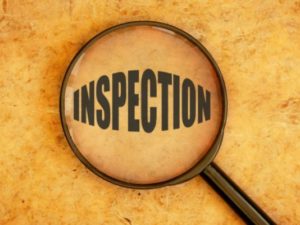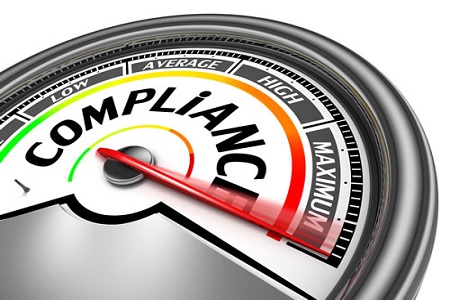State Health Departments
Food safety compliance inspections of food service establishments are performed by local state health inspectors to prevent the possibility of foodborne illness ourbreaks, to educate food service staff about safe food handling practices and basic sanitation requirements, and to enforce food safety regulations.
Most food service establishments fear the unannounced inspection. It would behoove the establishment to see the inspection as an opportunity to critically evaluate its health compliance standards.
Frequency of Health Inspections
Frequency of inspections may vary from state to state. They are usually determined on a risk based criteria assessment. The more complex the food handling operations of the establishment the more often the health department will visit. Whereas a smaller establishment ,such as a coffee house or small bakery, may only expect an annual visit.
Frequency will also increase depending on your prior scores. If someone reports your establishment for a foodborne illness or substandard operating procedure, the health department is mandated to perform an inspection. Complaints also result in additional inspections.
Health inspectors are oftentimes assigned to one particular area. Even though standard report procedures are available for review, the inspectors have broad discretion of how they conduct their inspections.
Usually the establishment will be inspected during standard operating hours. The inspector will request to speak with the manager. The employees may be informed that an inspection is in process. The inspector will usually review the last inspection report followed by management and employee food safety certifications, hazard analysis and critical control point plans, as well as permits and licenses. The order of inspected areas may vary but will most likely include the front receiving area, the kitchen, walk-ins, freezers, dishwashing and storage areas, service line, buffets, restrooms, dining rooms, bar, waiter service areas, dumpsters, and parking areas.

What to Expect During the Inspection
The style of the inspector may vary considerably. Some inspectors may educate on how to correct violations. Others may simply cite the violation without explanation. Questions and comments should be respected and clarified if necessary. Taking notes will show that you’re taking the inspection seriously and appreciating the constructive comments for further modification of your food handling program.
Some inspectors will allow you to correct violations on site. These may include quick fixes such as cleaning spray handle nozzles or lowering trash lids. Upon completion the inspector will review the report with the manager. The report is then left on site as well as posted to the Health Department’s website becoming public record.
The inspectors should be seen as educating and informing the manager of proper food handling requirements as well as correcting violations to protect the public from acquiring foodborne illnesses. It is helpful to review the inspection reports of other nearby food service establishments. Most health departments post reports along with the specific violations identified. The health department’s website offers health inspection forms and their restaurant inspection guidelines.
Common inspection items include:
- No missing or cracked tiles, lights protected with plastic shields or plastic tubes, air curtains working at delivery doors, doorways with air pumps for closure. Floors, floor drains, walls and ceilings clean and in good repair.
- Containers covered and labeled. Gaskets, fan guards,shelving, and all types of door handles clean.
- Thermometers present in all refrigeration units containing meat, poultry and seafood. Taking random temperatures of hot and cold foods at all stations to make sure temperatures are maintained at the proper levels for cold holding and hot holding.
- Dining room furnishings in good condition, restrooms properly stocked and in working condition, garbage and trash areas have proper receptacles that are covered and rodent proof, basements are rodent proof and with proper lighting.
- Storeroom door closed, everything stored six inches off the floor and away from walls, cans inverted, boxes sealed, no flies or insects in dry ingredients
- Single service items wrapped in original sleeve, to go boxes inverted, cases sealed closed.
- Can opener and blade clean, containers inverted, utensils stored handles up, clean equipment.
- Hair covered, uniforms clean, aprons on, condition of hands ( no cuts, rashes), gloves on, gloves available in a variety of sizes.
- Hand sinks clean, hot water 100 degrees F+, soap and paper towels available, trash can available with no obstacles in the way.
- Stoves, grills, fryers, vents, hoods and filters present and clean; kettles working.
- No cell phones in work or food areas, no beverages, food or tobacco in back of house
Most common violations:
Low risk violations include:
- Non food contact surfaces dirty or need repair
- Aging equipment and cooking utensils
- Improperly stored equipment, utensils and linens
- Improper maintenance of floors, walls and ceilings
- Plumbing fixtures need repair
Minor violations: ( requiring immediate correction)
- Food left out or stored in unsafe areas

- Inadequate hand washing facilities
- Improperly labeling and storage of chemical containers
- No rodents, insects or animals, major violation if infestation
- Improper eating, drinking, tobacco and cell phone use by employees
Major violations:
- Improper hot and cold holding temperatures
- Unsanitary handling of foods
- Improper sanitizing of food contact surfaces
- Communicable diseases of employees
- Improper heating procedures for hot holding
Health department grading systems can vary by jurisdiction. They can be in the form of letter grades, a point system or a pass/fail system along with possible fines. Be sure you know the system under which you are operating and the point penalties attached to different violations, as these points determine how your establishment performs during an inspection.
Join the conversation…ask Dr. Gary a question or leave a comment below.

Dr. Gary Russotti MD, MS
Idea Boxx- Director of Medical/Biochemical R&D and Regulatory Compliance
- Summarized from: Fitzgerald, M.” Restaurant Health Inspections: How to Make the Grade .” Menu Cover Depot.Feb 2015. P. 1-11.
- Magnifying Glass Image; https://www.wisconsinrapidstribune.com/story/news/2015/10/09/wood-county-health-department-inspections/73533496/
- Inspection Image; https://www.azcentral.com/story/news/local/phoenix/2017/12/27/restaurant-inspections-5-phoenix-area-eateries-weeks-list/982505001/







That is informative content ..
I added your site into my favourites.
P.S.: Looking forward for future updates!
Best regards,
Travis
Thank you Travis! We’re glad you enjoyed it. If you’d like, you can sign up for our blog or newsletter (in right-hand column) so you never miss a post! Have a great day.